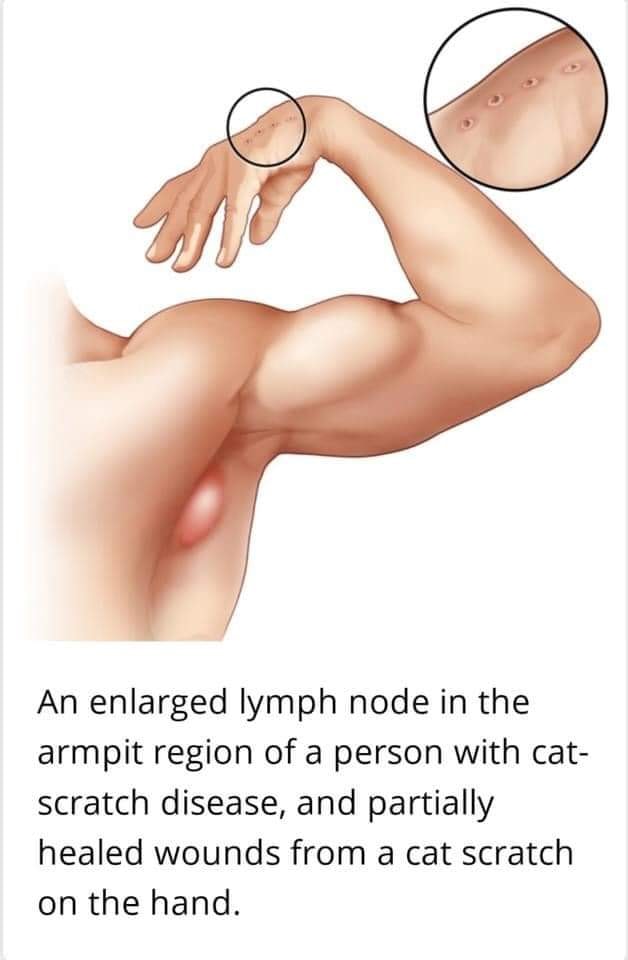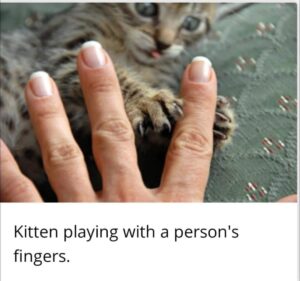Cat Scratch Disease (CSD) or Bartonellosis
What is cat scratch fever?
Cat scratch disease (CSD), also known as cat scratch fever or bartonellosis, is caused by a bacterial infection. There are at least 8 species of Bartonella implicated in causing human disease, while Bartonella henselae is the most common species found in cats. CSD can affect humans, dogs, cats, and other animals. The disease got its name as it often is associated with a cat scratch. Transmission of the bacteria actually occurs through cat fleas and possibly other biting flies or ticks. The flea ingests blood containing Bartonella from an infected cat, the bacteria replicates in the flea and is shed in the feces. Those feces can infect humans through scratches or other abrasions in the skin, as well as through the eye.
Cat scratch fever, also called cat scratch disease (CSD), is a bacterial infection. The disease gets its name because people contract it from cats infected with Bartonella henselae bacteria.
What causes cat scratch fever?
You can get cat scratch fever from a bite or scratch from an infected cat. You can also get the disease if saliva from an infected cat gets into an open wound or touches the whites of your eyes. Occasionally, you may get the disease from a flea or a tick carrying the bacterium.
You can’t get cat scratch disease from another human.
Who is at risk for cat scratch fever?
Anyone who owns or interacts with a cat is at risk of contracting cat scratch fever.
The CDC reports that cat scratch fever is most prevalent in the southern part of the United States and most common among children between the ages of 5 and 9 years old. People who were hospitalized were more likely than outpatients to be male, though the majority of people who are diagnosed are female.
You have an increased risk of becoming seriously ill from cat scratch fever if you have a weakened immune system. People who might fall into this category include those who are pregnant or who are living with:
What are the symptoms of cat scratch fever in cats?
Cats can carry B. henselae, but they don’t generally get sick from the bacteria. For this reason, you can’t always tell if they’re carriers. Cats likely contract the bacteria from infected fleas. In very rare instances, humans can contract the bacteria directly from fleas. According to the CDCTrusted Source, around 40 percent of cats carry the bacteria at some time in their lives, most commonly as kittens. Treatment for cats isn’t usually recommended.
What are the symptoms of cat scratch fever in humans?
Common symptoms of cat scratch fever include:
- a bump or blister at the bite or scratch site
- swollen lymph nodes near the bite or scratch site
- fatigue
- headaches
- a low-grade fever, which is above 98.6°F (37°C) but below 100.4°F (37°C)
- body aches
Less common symptoms of cat scratch fever include:
Rare symptoms of cat scratch fever may be linked to a more severe version of the disease. These symptoms include:
- backache
- chills
- abdominal pain
- joint pain
- rash
- prolonged fever
A bump or blister may develop on the skin at the site of infection 3 to 10 days after exposure. Other symptoms, such as swollen lymph nodes, may not occur for several days or weeks. Swollen lymph nodes typically occur between one and three weeks.
Conditions that may be mistaken for cat scratch fever include:
- lymphadenitis, an inflammatory disease that results in swollen lymph nodes
- brucellosis, an infection transmitted from livestock to humans that presents with flu-like symptoms and swollen lymph nodes
- lymphogranuloma venereum, a sexually transmitted infection (STI) that results in a skin lesion at the site of infection; the lesion may become a raised bump or blister and is followed by swollen lymph nodes
- Lyme disease, a tick-borne infection that has an initial symptom of a bull’s-eye rash before flu-like symptoms develop
What are the signs of cat scratch disease?
The typical signs are mild fever, chills, and lethargy (fatigue) accompanied by enlarged lymph nodes and lesions on the skin or conjunctiva (the membrane that covers the white of the eye and inside of the eyelid). Most symptoms last for a few days, but the enlarged lymph nodes may persist for weeks or months.
Physicians have traditionally been taught that CSD is a mild, self-limiting infection (one that typically goes away on its own, without the need for medication or other intervention). Although this is true for most cases, B. henselae and several other Bartonella species can occasionally cause chronic, asymptomatic, or intermittently symptomatic illness.
In these cases, a more severe disease can develop, with any combination of the following signs: arthritis, enlarged liver and spleen, high fever, nervousness, pneumonia, and weight loss. These more serious forms of the disease are often associated with an underlying immunodeficiency, for example, with HIV/AIDS infection or chemotherapy. However, at this time, we do not fully understand why some people contract a more serious form of bartonellosis.
How is cat scratch fever diagnosed?
If your doctor believes you may have cat scratch fever, they will perform a physical examination. Cat scratch fever is difficult to diagnose from the symptoms alone. A doctor can make an accurate diagnosis by performing a polymerase chain reaction (PCR) blood test to see if the B. henselae bacteria are present in your body.
What are the complications of cat scratch fever?
There are several possible, but rare, complications of cat scratch fever.
Encephalopathy
Encephalopathy is a brain disease that can occur when the bacteria spread to the brain. In some cases, encephalopathy results in permanent brain damage or death.
Neuroretinitis
Neuroretinitis is an inflammation of the optic nerve and retina. It causes blurred vision. The inflammation can occur when the bacteria responsible for cat scratch fever travels to the eye. Vision usually improves after the infection is gone.
Osteomyelitis
Osteomyelitis is a bacterial infection in the bones, which can result in bone damage. In some cases, the bone damage is so severe that amputation is necessary.
Parinaud oculoglandular syndrome
Parinaud oculoglandular syndrome is an eye infection with symptoms similar to pink eye. Cat scratch fever is one of the most common causes of this syndrome. It may result from B. henselae entering the eye directly, or from the bacteria traveling through the bloodstream to the eye. The syndrome usually responds well to antibiotic treatment. In rare cases, surgery is necessary to remove infected tissue from the eye.
How is cat scratch fever treated?
Cat scratch fever usually isn’t serious and generally doesn’t require treatment. Antibiotics can treat people with serious cases of cat scratch fever or weakened immune systems.
Azithromycin (Zithromax) is used to decrease lymph node volume quickly. It’s typically prescribed for five days. Other antibiotics sometimes used to treat cat scratch fever infections include:
- ciprofloxacin (Cipro)
- rifampin (Rifadin)
- tetracycline (Sumycin)
- trimethoprim-sulfamethoxazole (Bactrim, Septra)
Treatment times and dosage of these antibiotics vary depending on each clinical case, but they can last from five days to two weeks. Talk to your doctor about possible drug interactions. Drug interactions are also possible if you consume alcohol.
The blister or bump may last between one and three weeks. The swollen lymph nodes usually take two to four months to disappear, but can last from six months to a year or more. They can also result in other complications.
How can cat scratch fever be prevented?
You can prevent cat scratch fever by avoiding contact with cats. If you have a cat, avoid rough play that could lead to you being scratched or bitten. You can also keep their nails trimmed to reduce scratches. Washing your hands after playing with your cat may also help prevent the disease. Don’t allow your cat to lick or scratch at your eyes, mouth, or open wounds. You and your pets should also avoid feral cats.
Keep your cat indoors and administer antiflea medication to reduce the risk of your cat contracting B. henselae. Check your cat for fleas with a flea comb and control fleas in your home with frequent vacuuming. If necessary, a pest control agency can eliminate fleas in your home.
Because young cats and kittens are more likely to carry the disease, people with weakened immune systems can decrease their risk of catching the disease by adopting an older cat instead of a kitten.
When should I call a doctor?
Many cases of cat scratch fever resolve on their own, but some cases still require a doctor. Call a doctor if you or your child have been scratched or bitten by a cat and experience these symptoms:
- swollen or painful lymph nodes
- the injury doesn’t seem to be healing after a few days
- redness around the wound is expanding
- a fever develops a few days after the bite
If you’ve already been diagnosed with cat scratch fever, you should call your doctor as soon as possible if you experience:
- increased pain in the lymph nodes
- a high fever
- a feeling of malaise
- new symptoms
SOURCE- https://www.healthline.com/health/cat-scratch-disease#outlook




